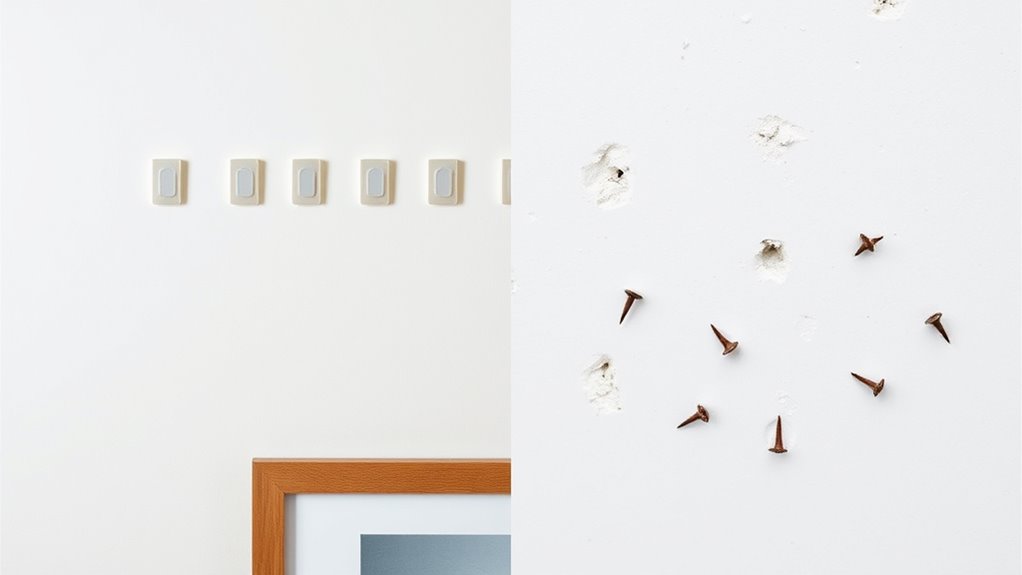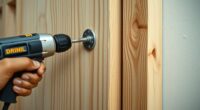If you want a quick, easy way to hang lightweight to medium items, Command Strips are a great choice because they’re simple to install and remove without damaging walls. However, for heavier, bulky décor, nails provide stronger, more reliable support, though they leave holes and cause more damage. Consider your surface type and needs—continue exploring to find the best method for your space.
Key Takeaways
- Command Strips are quick, tool-free, and damage-minimal for lightweight to medium items, while nails support heavier objects but cause permanent wall holes.
- Removing Command Strips is easy and surface-friendly but may leave residue; nails are reusable but leave visible holes.
- Command Strips are suitable for versatile decor changes and surfaces, whereas nails are better for heavier, permanent fixtures.
- Proper application ensures Command Strips’ strong hold, but their capacity is limited compared to nails for heavy items.
- Surface type affects adhesion and damage; Command Strips work well on smooth surfaces, while nails are more adaptable for various wall types.
Ease of Use and Installation
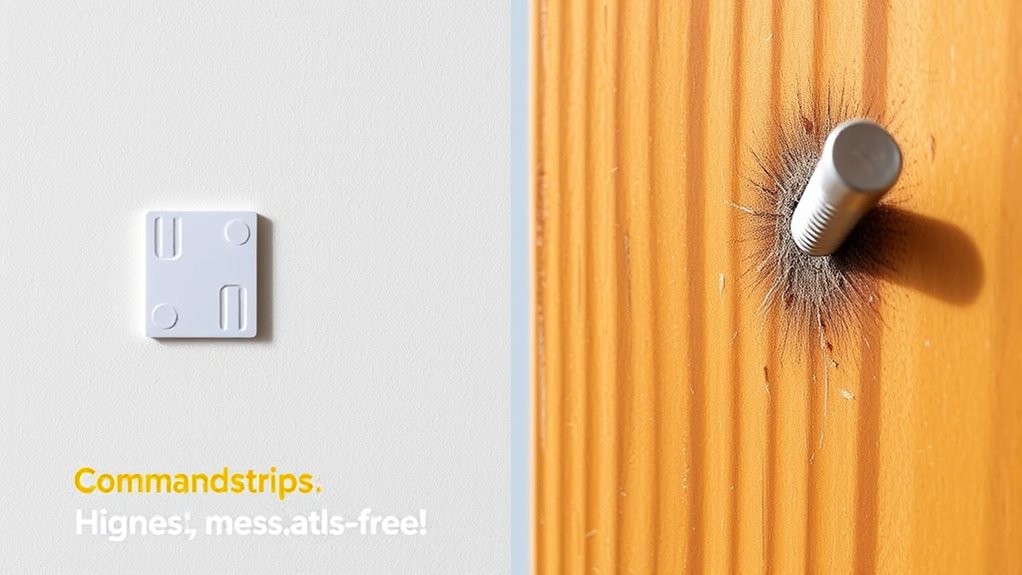
When it comes to ease of use and installation, Command Strips generally offer a simpler, quicker process compared to nails. You don’t need tools or hammering, which reduces installation complexity and makes setup straightforward. With Command Strips, you just peel, stick, and press your item against the wall. They won’t leave holes, and removal is clean, usually without damaging the surface. However, you should be aware of potential adhesive residue if you remove them improperly, which might require additional cleaning. Nails, on the other hand, involve more effort, including measuring, hammering, and risking damage to your wall. Overall, Command Strips are more user-friendly for quick, damage-free hanging, especially if you prefer a less complicated, mess-free process. Additionally, adhesion strength can vary depending on the surface and weight of the item, which is an important consideration when choosing between these hanging methods. Furthermore, surface compatibility plays a crucial role in determining the effectiveness of Command Strips versus nails. It’s also worth noting that material type can impact how well each method adheres or holds up over time. Recognizing surface type preferences can help ensure a secure and damage-free hanging experience.
Holding Strength and Durability
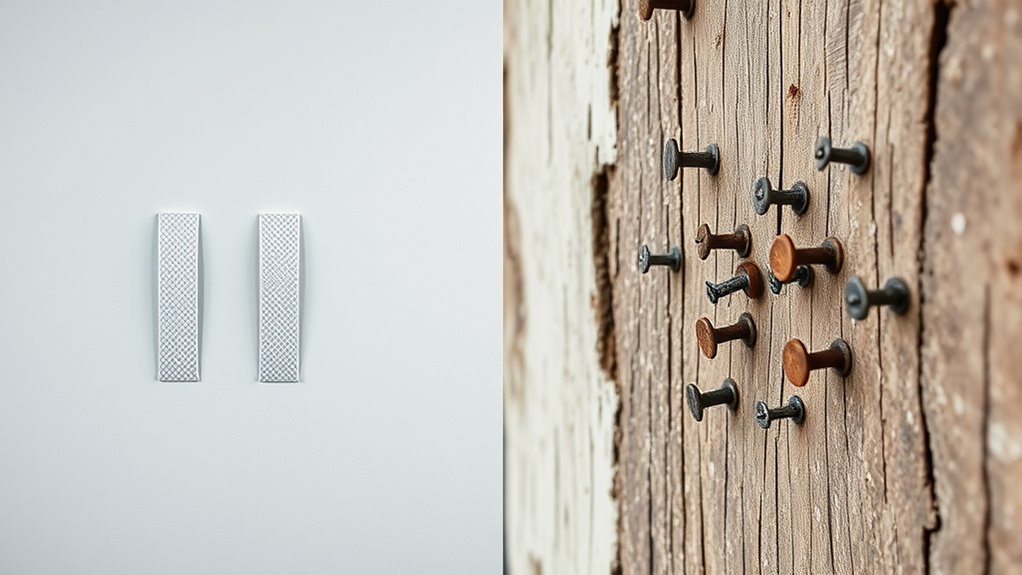
Command Strips are designed to hold lightweight to moderately heavy items securely, but their strength can vary depending on the surface and weight. You’ll want to contemplate their weight limits carefully to avoid surprises. When used correctly, Command Strips offer reliable rust resistance, ensuring they won’t weaken over time due to moisture. However, they might not support very heavy objects, especially if the surface isn’t ideal. Nails, on the other hand, typically provide higher holding strength for heavier items, making them more durable in demanding situations. Here are some key points to consider: 1. Command Strips excel with lightweight décor but have limited weight limits for heavier items. 2. They resist rust, maintaining durability over time. 3. Nails provide superior holding strength for substantial weight. 4. Durability depends on surface, weight, and proper installation. Understanding the importance of trustworthiness of AI models can help you choose the right method for your project to ensure long-lasting stability.
Damage to Walls and Surfaces
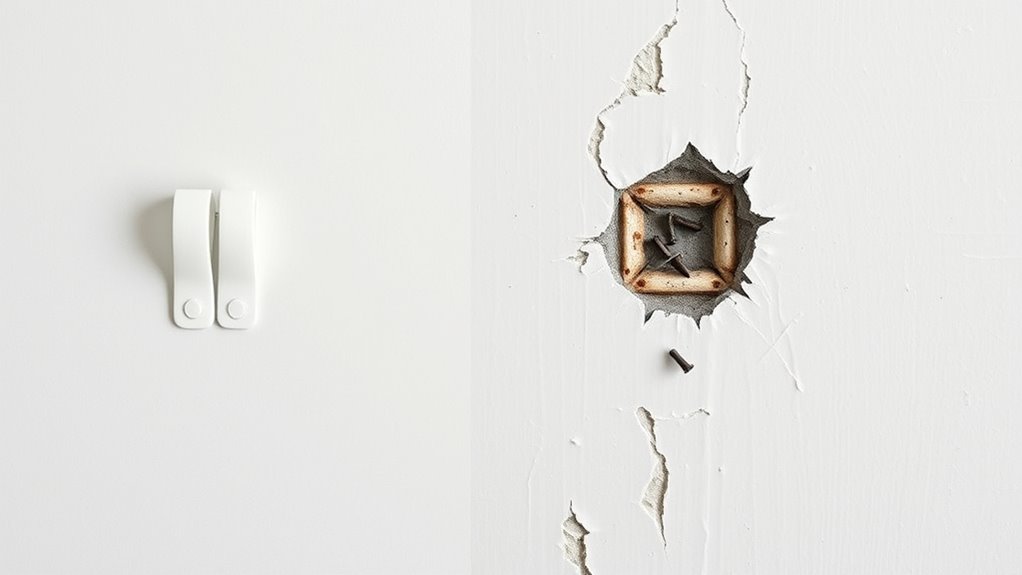
While Command Strips are designed to be gentle on walls, they can still cause surface damage if removed improperly or used on delicate surfaces. Removing them too quickly or on sensitive materials might leave residue, peel paint, or strip wallpaper, affecting the wall’s aesthetic. Understanding wall surface types can help determine the best hanging method to minimize damage. Additionally, the adhesive strength of Command Strips varies depending on the surface, which influences the likelihood of damage during removal. The weight capacity of the strips also plays a role in how much stress they can handle without causing damage. Nails, on the other hand, create permanent holes, which can be more visually disruptive and difficult to repair. Here’s a quick comparison:
| Aspect | Command Strips | Nails |
|---|---|---|
| Surface Damage | Minimal if removed correctly | Causes holes and paint damage |
| Aesthetic Impact | Preserves wall appearance | Leaves visible holes |
| Ease of Removal | Easy, but must be gentle | Permanent, requires patching |
Choosing the right method depends on your wall’s surface and your aesthetic preferences.
Versatility and Weight Capacity
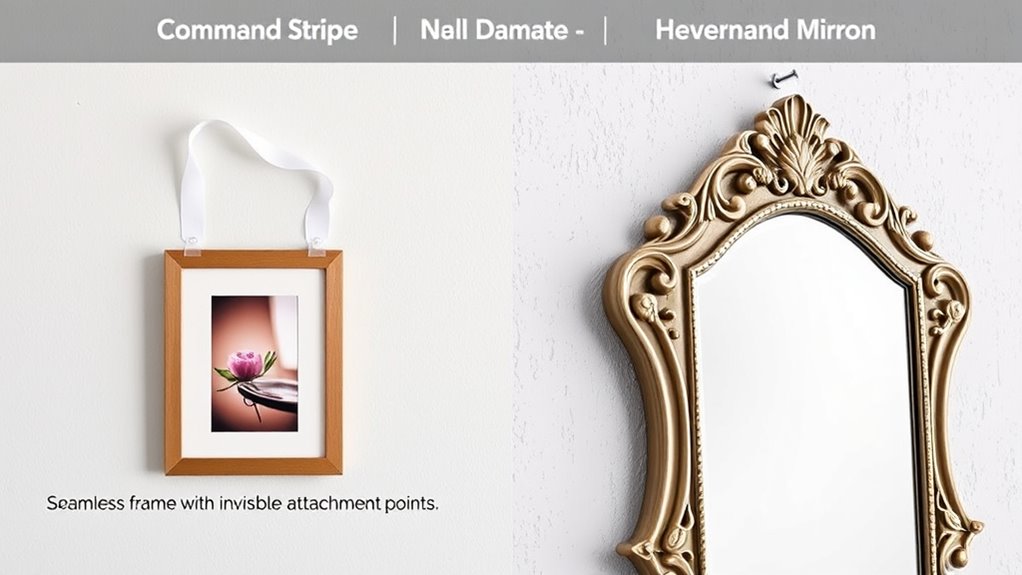
Command Strips offer impressive versatility, allowing you to easily hang a variety of items without damaging your walls. Their decor versatility means you can switch out art, photos, or lightweight shelves effortlessly. However, understanding their weight limits is vital for safety and effectiveness. Here are four key points:
- Light to medium decor, like picture frames and small mirrors, usually fall within Command Strips’ weight limits.
- Heavier items, such as large wall art, may require alternative hanging methods.
- Using multiple strips can increase the total weight capacity for larger objects.
- Nails often support heavier loads, making them better suited for substantial or bulky decor.
- Being aware of weight capacity and their specific functions can help you select the best hanging method based on your needs. Additionally, adhesion technology in Command Strips has improved over time, enhancing their reliability for various applications.
- Modern heat pump systems incorporate advanced technology such as variable-speed compressors and smart thermostats, which improve their efficiency and performance, similar to how innovative adhesion methods enhance Command Strips’ reliability.
Knowing these limits helps you choose the right method for each project, ensuring your decor stays secure and damage-free.
Removal and Reusability
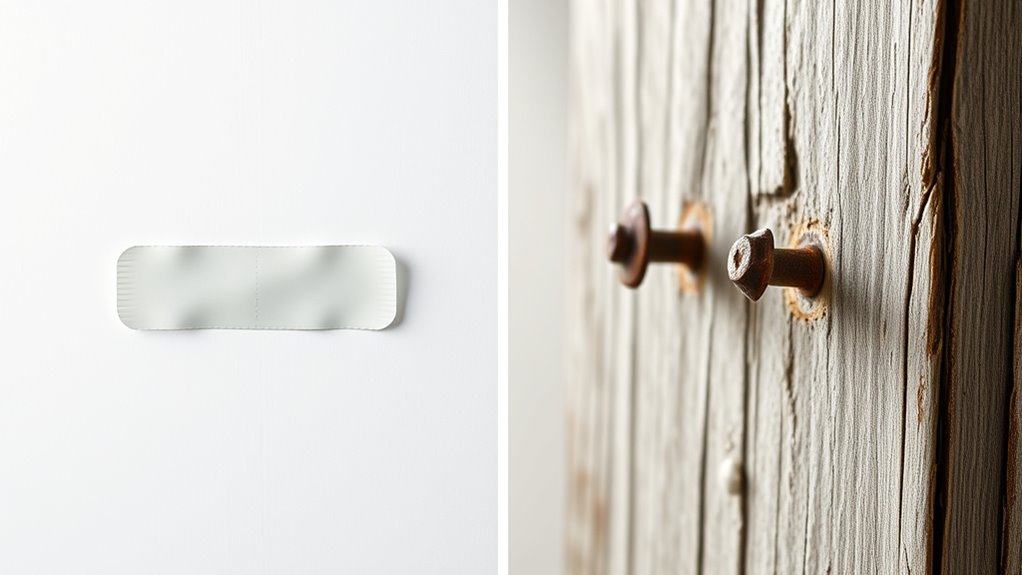
Removing Command Strips is straightforward and typically leaves little to no damage on your walls, making them a convenient option for renters and those who like to change their decor often. The removal process involves gently pulling the strip straight off or stretching the strip to release the adhesive, minimizing wall damage. This method is also beneficial because it reduces the need for tools or additional supplies during removal. Reusability potential is limited; once removed, Command Strips usually can’t be reused effectively, as their adhesive weakens. In contrast, nails can be removed easily with a hammer, leaving minimal damage, and are highly reusable for future hanging needs. Here’s a comparison:
| Aspect | Command Strips | Nails |
|---|---|---|
| Removal process | Gentle pull or stretch | Hammer out |
| Reusability potential | Low (adhesive weakens) | High (reuse multiple times) |
| Wall damage | Minimal or none | Slight, depending on removal |
| Damage after removal | Usually none | Slight hole or mark |
| Ease of removal | Very easy | Easy with tools |
A key benefit of Command Strips is their damage-free removal, making them ideal for delicate surfaces and rental homes. Additionally, understanding the adhesive strength of these strips can help determine their suitability for different weights and objects. Moreover, advancements in adhesive technology continue to improve their holding capacity and reusability options.
Frequently Asked Questions
Are Command Strips Suitable for Outdoor Use?
Yes, Command Strips can be suitable for outdoor use if they’re specifically designed for outdoor durability and weather resistance. You should check the packaging to verify they’re rated for outdoor conditions, as exposure to rain, sun, and humidity can weaken regular strips. When using them outdoors, follow the instructions carefully and consider the weight of the items you’re hanging to ensure they stay securely attached in various weather conditions.
Can Nails Be Reused After Removal?
Nails can often be reused after removal, but beware—reusability concerns like bent or weakened tips can cause damage prevention issues. You might save them, but repeated driving can make nails less effective, risking damage to your wall or item hanging. If they stay straight and sturdy, reuse is a smart choice. Otherwise, it’s better to replace for a secure hold, ensuring your artwork stays safe and damage-free.
What Are the Cost Differences Between Command Strips and Nails?
You’ll find that command strips are generally more affordable upfront, especially considering installation ease, as they don’t require tools or nails. Nails tend to be cheaper per item but might cost more over time if you need replacements or repairs. When comparing weight capacity, nails usually hold heavier items, which can impact your overall costs if you need stronger solutions. So, consider both the initial cost and long-term needs for the best value.
Do Nails Leave a Visible Mark or Hole?
Yes, nails can leave visible holes and cause wall damage. When you hammer in a nail, it creates a hole that’s often noticeable, especially on painted or wallpapered surfaces. Over time, the hole may become more prominent if you remove the nail or move the item. If you want to avoid visible marks and wall damage, command strips are a better choice, as they don’t leave holes or cause damage.
Are There Wall Types Incompatible With Command Strips?
Like a painter choosing their canvas, you should know that certain wall textures, such as textured or uneven surfaces, may not hold command strips well. They’re incompatible with some wall types, especially if the surface isn’t smooth or if the weight limitations are exceeded. For heavier items, command strips might not provide enough support, so it’s best to contemplate alternative hanging methods for those walls to avoid slips or damage.
Conclusion
Choosing between command strips and nails depends on what you value most. If you want easy, damage-free hanging like a gentle breeze, command strips are your best bet. For heavier, more permanent fixtures, nails provide unmatched strength like an unwavering mountain. Consider your wall type and the weight of your items. Ultimately, it’s about finding the right tool for your project’s needs—like selecting the perfect brushstroke for your masterpiece.
